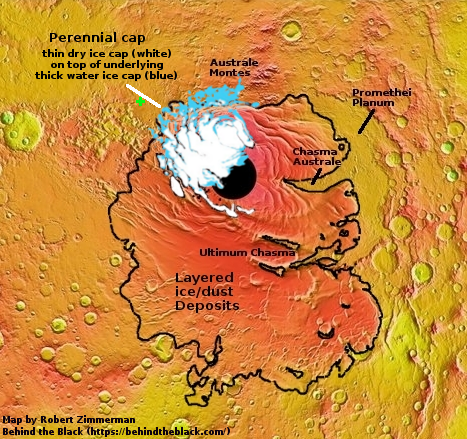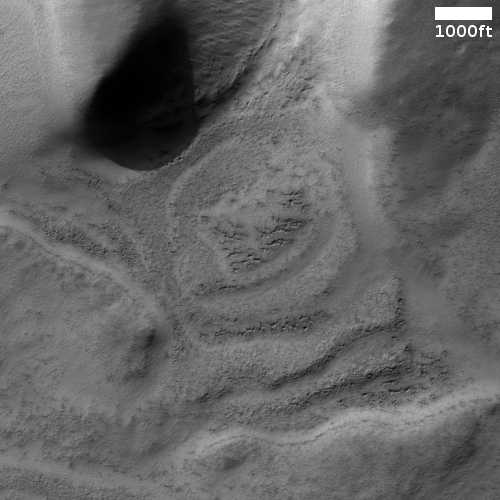Frozen lake bed in the Martian high latitudes?
Today’s cool image comes from today’s Mars Reconnaissance Orbiter’s (MRO) high resolution picture of the day, rotated and cropped to post here. The original was taken back on March 28, 2017.
What formed those strange circular ridges and the many small cracks and hollows? The caption provided is somewhat vague and I think confusing:
This formation looks like a crater from a meteor impact rather than an ancient caldera of a volcano. Connected to the crater is a carved-out area that resembles a lake bed. At high resolution, we might be able to determine the likelihood of a water lake bed or lava bed. This observation will give insight into some of the interesting geology of this area.
The crater this caption is referring to is not visible in the image provided. It can be seen to the west of this location, in the MRO context camera picture below.

The white box marks the location of the photo above. The crater referred to in the caption is the rimless round crater to the west of the very irregularly-shaped depression. The caption says that crater was probably created by an impact, but the lack of a rim suggests otherwise.
I think the answer, based on our presently very limited amount of information, is hinted at by the location, which is at 80 degrees south latitude, only about 400 miles from the south pole, as shown by the green cross in the overview map below and to the right. The answer is also indicated by the many glacial-like features that seem to permeate the crater, the surrounding terrain, and the primary photo above.
What we have here might be an ancient volcanic caldera or dried lake bed — as suggested by the caption — but I think the influence of glacial ice has been far more important to its formation. The surface features seen throughout these photos all appear to be glacial ice, with some showing layers signaling many cycles of formation and then sublimation. Those cycles likely worked to not only erode the crater, they carved out the irregular depression.
In the photo above we are getting a close look at some of that ice, which appears possibly exposed so that much of it can sublimate away when the Sun hits it. Thus, the cracks and hollows.
The particular location in the top photo also appears to be the resurgence for ice leaking from that irregular depression. The multiple ridges near the photo’s bottom also suggest multiple glacial flows, each traveling a shorter distance and thus leaving multiple moraines forming those ridges.
On Christmas Eve 1968 three Americans became the first humans to visit another world. What they did to celebrate was unexpected and profound, and will be remembered throughout all human history. Genesis: the Story of Apollo 8, Robert Zimmerman's classic history of humanity's first journey to another world, tells that story, and it is now available as both an ebook and an audiobook, both with a foreword by Valerie Anders and a new introduction by Robert Zimmerman.
The print edition can be purchased at Amazon or from any other book seller. If you want an autographed copy the price is $60 for the hardback and $45 for the paperback, plus $8 shipping for each. Go here for purchasing details. The ebook is available everywhere for $5.99 (before discount) at amazon, or direct from my ebook publisher, ebookit. If you buy it from ebookit you don't support the big tech companies and the author gets a bigger cut much sooner.
The audiobook is also available at all these vendors, and is also free with a 30-day trial membership to Audible.
"Not simply about one mission, [Genesis] is also the history of America's quest for the moon... Zimmerman has done a masterful job of tying disparate events together into a solid account of one of America's greatest human triumphs."--San Antonio Express-News
Today’s cool image comes from today’s Mars Reconnaissance Orbiter’s (MRO) high resolution picture of the day, rotated and cropped to post here. The original was taken back on March 28, 2017.
What formed those strange circular ridges and the many small cracks and hollows? The caption provided is somewhat vague and I think confusing:
This formation looks like a crater from a meteor impact rather than an ancient caldera of a volcano. Connected to the crater is a carved-out area that resembles a lake bed. At high resolution, we might be able to determine the likelihood of a water lake bed or lava bed. This observation will give insight into some of the interesting geology of this area.
The crater this caption is referring to is not visible in the image provided. It can be seen to the west of this location, in the MRO context camera picture below.

The white box marks the location of the photo above. The crater referred to in the caption is the rimless round crater to the west of the very irregularly-shaped depression. The caption says that crater was probably created by an impact, but the lack of a rim suggests otherwise.
I think the answer, based on our presently very limited amount of information, is hinted at by the location, which is at 80 degrees south latitude, only about 400 miles from the south pole, as shown by the green cross in the overview map below and to the right. The answer is also indicated by the many glacial-like features that seem to permeate the crater, the surrounding terrain, and the primary photo above.
What we have here might be an ancient volcanic caldera or dried lake bed — as suggested by the caption — but I think the influence of glacial ice has been far more important to its formation. The surface features seen throughout these photos all appear to be glacial ice, with some showing layers signaling many cycles of formation and then sublimation. Those cycles likely worked to not only erode the crater, they carved out the irregular depression.
In the photo above we are getting a close look at some of that ice, which appears possibly exposed so that much of it can sublimate away when the Sun hits it. Thus, the cracks and hollows.
The particular location in the top photo also appears to be the resurgence for ice leaking from that irregular depression. The multiple ridges near the photo’s bottom also suggest multiple glacial flows, each traveling a shorter distance and thus leaving multiple moraines forming those ridges.
On Christmas Eve 1968 three Americans became the first humans to visit another world. What they did to celebrate was unexpected and profound, and will be remembered throughout all human history. Genesis: the Story of Apollo 8, Robert Zimmerman's classic history of humanity's first journey to another world, tells that story, and it is now available as both an ebook and an audiobook, both with a foreword by Valerie Anders and a new introduction by Robert Zimmerman.
The print edition can be purchased at Amazon or from any other book seller. If you want an autographed copy the price is $60 for the hardback and $45 for the paperback, plus $8 shipping for each. Go here for purchasing details. The ebook is available everywhere for $5.99 (before discount) at amazon, or direct from my ebook publisher, ebookit. If you buy it from ebookit you don't support the big tech companies and the author gets a bigger cut much sooner.
The audiobook is also available at all these vendors, and is also free with a 30-day trial membership to Audible.
"Not simply about one mission, [Genesis] is also the history of America's quest for the moon... Zimmerman has done a masterful job of tying disparate events together into a solid account of one of America's greatest human triumphs."--San Antonio Express-News



